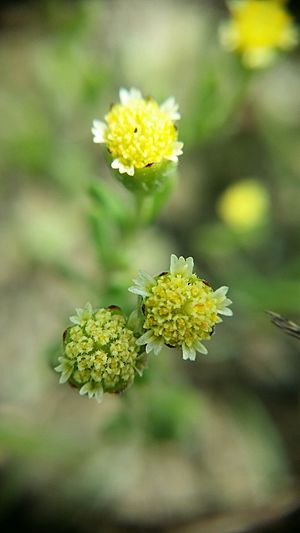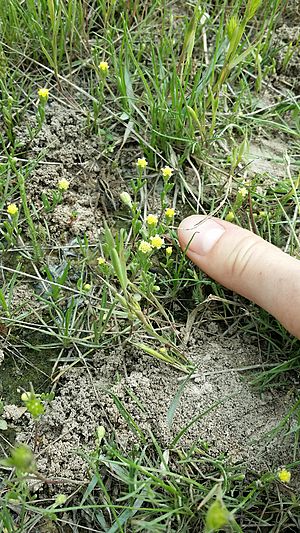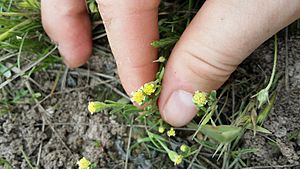Prairie dawn facts for kids
Quick facts for kids Prairie dawn |
|
|---|---|
 |
|
| Hymenoxys texana | |
| Conservation status | |
| Scientific classification | |
| Kingdom: | |
| (unranked): | |
| (unranked): | |
| (unranked): | |
| Order: | |
| Family: | |
| Genus: |
Hymenoxys
|
| Species: |
H. texana
|
| Binomial name | |
| Hymenoxys texana (J.M.Coult. & Rose) Cockerell
|
|
| Synonyms | |
|
|
Hymenoxys texana is a very rare flowering plant. It belongs to the aster family, which includes sunflowers and daisies. People call it by several names, like prairie dawn or Texas prairie dawn-flower. It is also known as Texas bitterweed.
This plant is only found in Texas, especially near the city of Houston. It is an endangered species in the United States. This means it is at risk of disappearing forever. Its main threat is that its natural home is being lost.
Contents
What Does the Texas Prairie Dawn Look Like?
Hymenoxys texana is a small plant that lives for only one year. It grows to be about 10 to 15 centimeters (4-6 inches) tall. Its stems are thin and can be reddish or purplish.
The leaves of the plant feel a bit rubbery. They might be simple or divided into several parts, especially in the middle of the stem.
Its Unique Flowers
The plant produces small, single flower heads or a few heads in a loose group. Each flower head is less than one centimeter wide. It has 6 to 8 yellow "ray florets." These are like the petals you see on a daisy. Each ray floret is only 2 or 3 millimeters long.
Sometimes, these yellow ray florets are hidden behind green leaf-like parts called phyllaries. In the center of the flower head, there are many tiny "disc florets." There can be anywhere from 30 to 75 of these tiny flowers.
Where Does the Texas Prairie Dawn Live?
Hymenoxys texana grows only in the grasslands of the Gulf Coastal Plain in Texas. It likes open, bare areas with salty, sandy soil. You can often find it at the bottom of small hills called Mima mounds.
The soil where it grows can be quite special. During the wet season, it might be covered with a slippery layer of algae (a type of tiny plant-like organism). When the dry season comes, this soil dries out, cracks, and becomes very powdery. Not many other plants can grow in these tough conditions. However, you might sometimes see another plant called prairie dogshade (Limnosciadium pumilum) growing nearby.
Why Is This Plant Endangered?
The Texas prairie dawn is currently found only in Harris and Fort Bend Counties in Texas. It was first discovered and described in 1891 near a place called Hockley. For many years, people didn't see many of these plants. By 1979, scientists even thought it might be extinct, meaning it had completely died out.
Luckily, just two years later, in 1981, the plant was found again! Today, there are about 50 known groups of these plants. However, almost all of them are in danger. Their homes are being destroyed or damaged. Many of these plants live in or near the Houston metropolitan area. This area is growing very fast, and land is being used for new homes and other buildings. This growth takes away the special places where the Texas prairie dawn can live.
See also
 In Spanish: Hymenoxys texana para niños
In Spanish: Hymenoxys texana para niños




